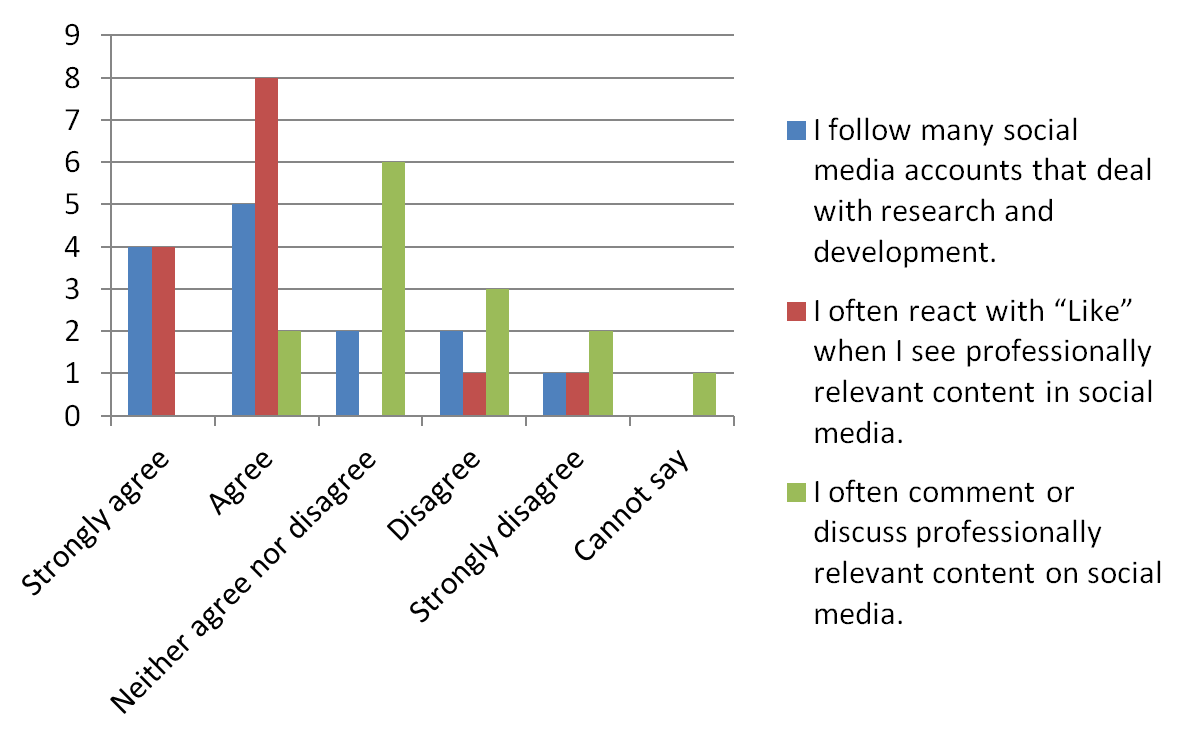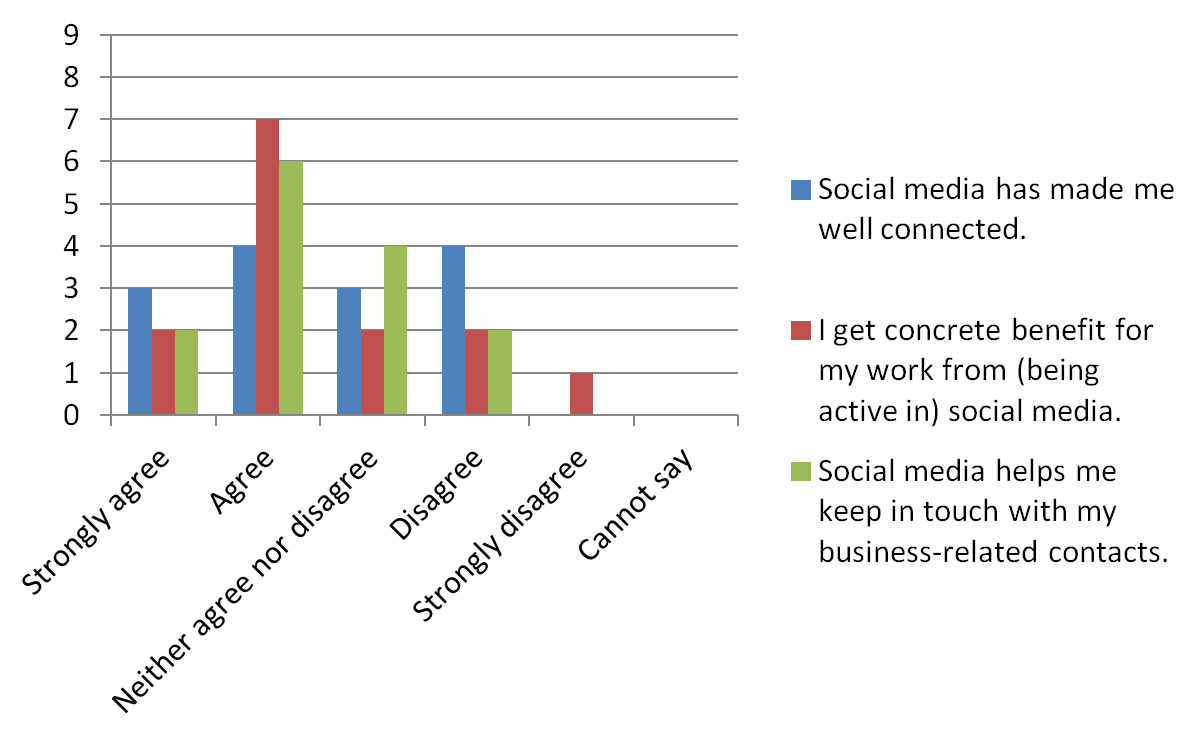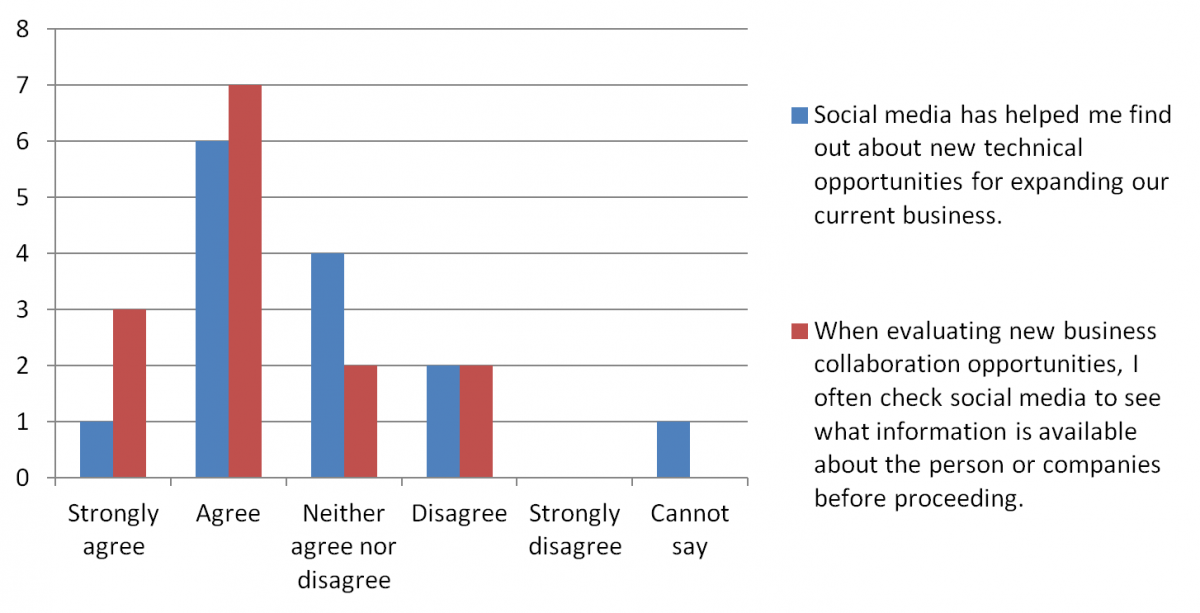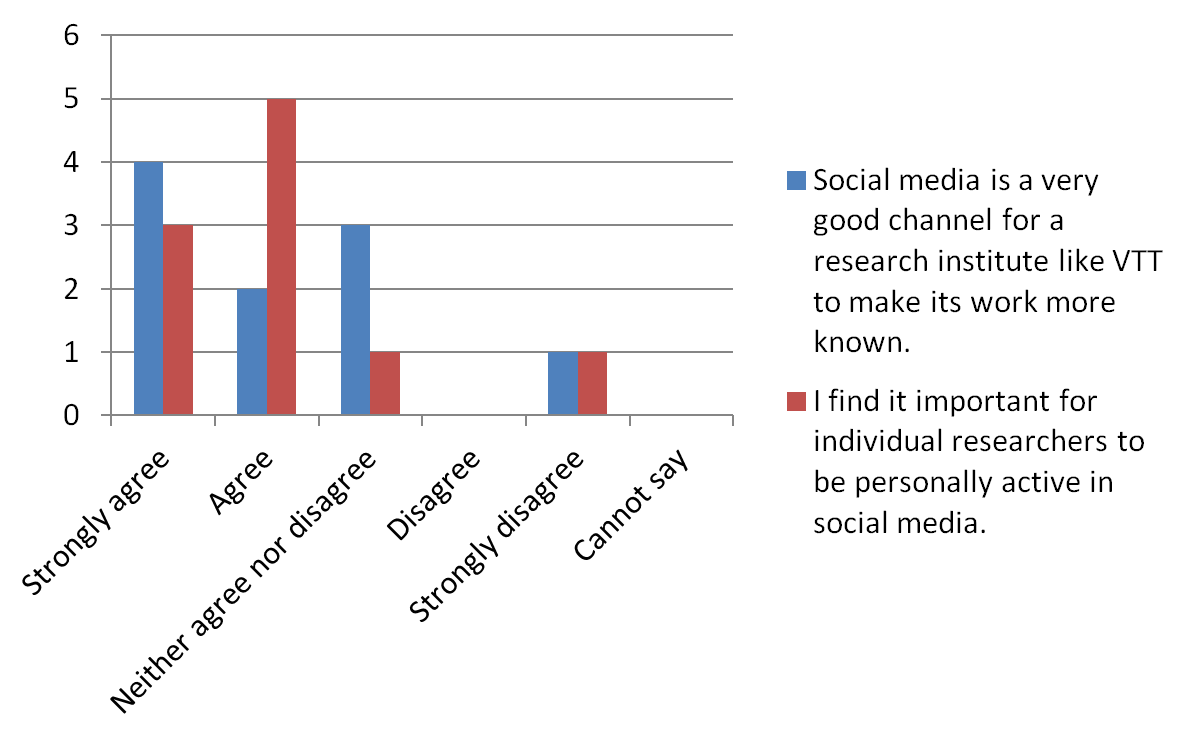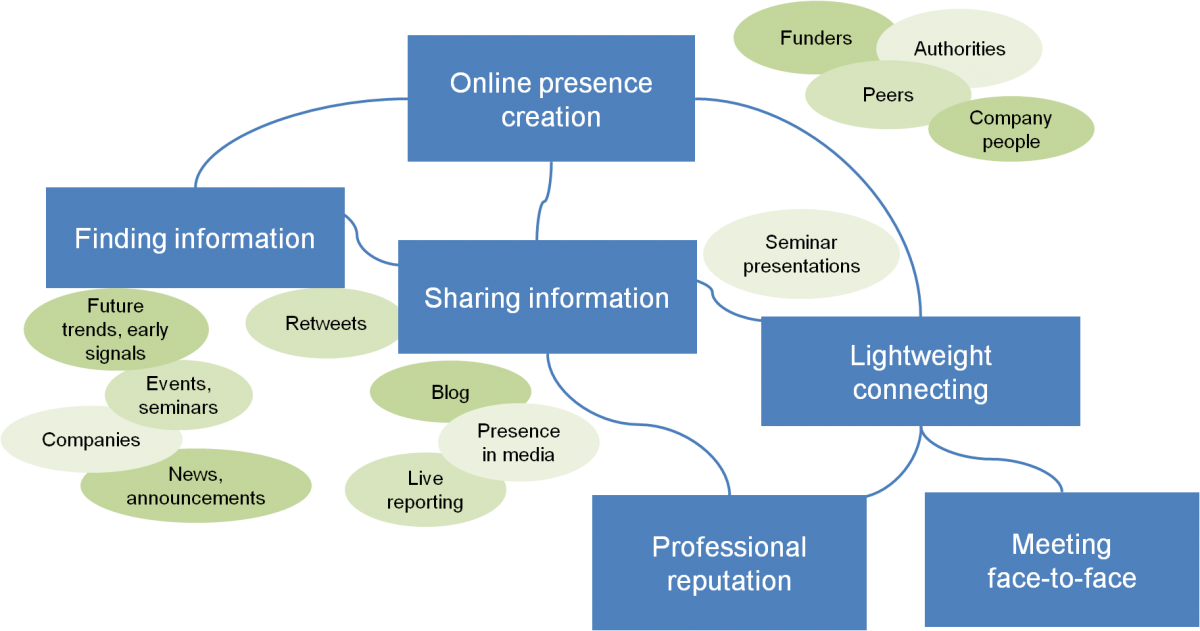AbstractWe don’t have a choice on whether we do social media, the question is how well we do it.
Erik Qualman
Author and speaker
Social media is now an essential information and interaction channel. Companies advertise and sell their products and services through social media, but this channel has not been so commonly applied to the task of selling knowledge and research work. This article studies the use of social media by researchers to promote their research and network with product developers in industry, and it presents a model of the use of social media by researchers. The data for this research was obtained by interviewing individual researchers of a research organization and surveying product developers from industry. The findings show that social media is seen as a good source of new information and contacts, and it is suitable for promoting awareness of research services and results. The results show that the speed and intensity of social media present challenges for researchers, but by being active in posting content and participating in discussions, researchers can derive benefits and enhance their personal reputations.
Introduction
Social media has become a popular and easy-to-access way for customers to find information before committing to a specific buying decision (Tenhunen, 2017). Social media employs “mobile and web-based technologies to create highly interactive platforms via which individuals and communities share, co-create, discuss, and modify user-generated content” (Kietzmann et al., 2011). Categories of social media services include social networking (e.g., Facebook, LinkedIn), microblogging (e.g., Twitter), blogging, photo sharing (e.g., Instagram, Pinterest), video sharing (e.g., YouTube), and crowdsourcing. Successful adoption of social media can increase companies’ turnover (Tsimonis & Dimitriadis, 2014) and have an impact on their reputation or even survival (Kietzman et al., 2011). An organization can be present in social media at different levels: as individuals, teams, projects/topics, and as the whole organization. However, given that social media is person-centric, it gives users the opportunity of “personal branding” – the distinctive presentation of a person’s character and capacity (Lair et al., 2005).
The use of social media in business has been intensively studied, but the focus has been much more on the business-to-consumer (B2C) sector than the business-to-business (B2B) sector (Michaelidou et al., 2011). The key differences between B2B and B2C marketing are that B2B markets often deal with high-value and complex products that are marketed to knowledgeable decision makers and that B2B marketing requires more intense, long-term personal relationships between the buyer and seller than what is typical in the consumer market (Table 1).
Table 1. Differences between B2B and B2C marketing (Habibi et al., 2015; Jussila et al., 2014; Urban et al., 1993)
|
Features of B2B vs. B2C Marketing |
Impact |
|
Larger number of decision makers and purchase influences |
B2B marketers must consider a greater number of communication channels and messages. Finding the key decision maker is a challenge. |
|
Slower decision-making cycle |
The length of the purchase funnel must be recorded in B2B for each decision maker to match resources with potential purchases. |
|
High-value exchange; more complex products |
B2B purchasers rely more on direct and intense personal relationships and sales contacts than on advertising. Different messages are needed for different decision makers. |
|
Higher level of risk due to high-value purchases and product complexity |
B2B buyers are more rational and knowledgeable in decision making. |
|
More functional, rational, or utilitarian decision-making criteria |
The message and media of B2B sales should rely on factual information. |
A special case of B2B is selling research to industry, because often there is no concrete product or service, only existing competences. The role and opportunities for using social media in enhancing research-to-business communication and transferring research results to industry have been researched only in few studies (e.g., Mauroner & Fauck, 2014). Most universities and research institutes use social media to some extent, but its true potential is unclear. Close collaboration between a research institute, its researchers, and industry is important also for the society, because the quicker the research results are commercialized, the bigger the benefits are to the companies and the society (Komssi et al., 2016). Therefore increasing understanding of how social media can be used efficiently is worth researching.
Research Problem, Method, and Case Organization
In this article, we study the use of social media by researchers from research institutes to promote their research and network with industry from the perspectives of researchers and potential customers.
Our overall research question is:
What is the role of social media in connecting researchers, research institutes, and companies?
However, this research question consists of two sub-questions:
- How do researchers use social media, and do they use it to promote their research and co-operate with companies?
- How and to what extent do potential customers and business partners use social media to find information on research to support their innovation activities?
The main research method is a case study of researchers from VTT, the leading research and technology development company in the Nordic area. VTT has been increasingly using social media at an organizational level to support and complement other communications activities. VTT management encourages individuals at VTT to be active in social media as experts to promote their research and raise general awareness of the research institute nationally and internationally. VTT’s social media policy is that an individual professional profile can be created without notifying any manager or communications department, but if a profile is created for an organizational entity such as a team, the communications department should be notified about it. Brief training sessions are organized occasionally to help people get started and to share good practices.
The research data was gathered through interviews and an online survey. Twelve VTT researchers were interviewed related to their social media use and experiences, and an online survey was created and targeted at potential customers (i.e., people working with the development of new products and services). The details of the data collection are explained in more detail in connection with the results.
Background Research
Mauroner and Fauck (2014) researched the use of social media at the German research institute Fraunhofer Society in 2010 and 2014. Their research shows that many research institutes behave conservatively with regard to social media and, although social media use had increased a lot at Fraunhofer between 2010 and 2014, neither the central office nor the institutes monitored it. Their research found that social media strategies are needed to address decision makers in companies and research organizations, politicians, and research sponsors. Social media offers many possibilities for research institutes to spread information and obtain knowledge about the needs of the target group and to adjust its own service portfolio.
Lacoste (2016) interviewed account managers to develop a key customer engagement model. Her major finding was that, for key account managers, virtual social networking typically is the first step toward more personal and face-to-face relationships. It was a type of entrance gate toward customer engagement. The openness and the presence of competitors were experienced as inhibitors to social media use among the interviewed key account managers.
Keinänen and Kuivalainen (2015) explored the behaviour of B2B customers regarding their social media use for business purposes. Their study showed that private social media usage has the most significant relationship with the social media business use; however, social media was not always experienced as useful.
Swani, Brown, and Milne (2014) analyzed more than 7000 tweets by Fortune 500 companies and concluded that marketers in B2B and B2C settings exhibit significant differences in their branding and selling strategies. In an earlier study, Swani and co-authors (2013) investigated the key factors that contribute to Facebook brand content popularity metrics for Fortune 500 companies’ brand posts in B2B versus B2C markets. The results of their study indicate that the inclusion of corporate brand names, functional and emotional appeals, and information search cues increase the effectiveness of B2B messages.
Järvinen and colleagues (2012) researched the social media use of 145 B2B firms from different industries. They concluded that, despite the interest in social media, companies tend to focus on one-directional communications with established digital tools. Additionally, their research indicated that the advances in digital data analysis tools remain largely unexploited. The firms also lacked human resources and expertise to exploit the opportunities provided by the developing digital environment.
In a later study, Järvinen and Taiminen (2016) studied organizational processes of B2B content marketing in terms of creating and delivering timely and valuable content, the use of content marketing automation, and marketing and sales alignment. Their key finding was that content in social media needs to be created by taking into consideration the information needs of the customers. The content must give value to the customers, for example by providing advice and helping to solve practical problems. They also emphasize that learning takes time and that the management needs to support this learning process.
Experiences of VTT Researchers in Social Media
Twelve VTT researchers were interviewed about their practices and experiences of professional social media use. The subjects of this study were researchers because their professional competences are central to the topic. Although researchers do not have direct sales responsibility in the organization, in effect, it is their skills and knowledge that is being sold; therefore, researchers play an important role in promoting the organization’s research services. The selected interviewees were researchers who had at least 150 followers in Twitter and used social media at least once a week on average. Three of the researchers were female and nine were male; three of them were under 35 years, five were between 35–45 years, and four were over 45 years old. The interview questions were sent to them in advance. Each interview took from 1 to 1.5 hours and was recorded and transcribed.
The themes of the interview were the interviewee’s history of social media use, their goals of professional social media use, their ways of using social media, and their experiences of using social media. The questionnaire also included some statements regarding making connections to companies and other researchers, and the benefits of social media use. Each interviewee was asked to indicate how much they agreed or disagreed with the statements from “strongly agree” to “strongly disagree”.
The following subsections summarize the results focusing on three main aspects: why and how researchers were using social media; how beneficial they regarded their use of social media; and what kind of challenges they experienced.
Why and how
Many of the interviewees had used social media privately for several years. Twitter was currently the most actively used channel for the interviewees, and it had typically been in use from one to four years.
“I have used LinkedIn more than 10 years, but it is more like a rolodex as it does not offer as effective a news feed as Twitter.”
Some of the researchers had started to use social media out of social pressure from peers, some out of curiosity, and some because they were involved in projects that required being present in social media.
“I was on a business trip and met social media people who made me notice that I was ‘out’ and I decided to become active in social media.”
All interviewees used social media to find information and stay up-to-date with the latest developments. Some used special tools and services to keep track of developments relating to their professional topics. Several interviewees mentioned learning to use social media and learning new things in general as their motivations.
The interviewees provided content to social media mainly by sharing links to content available in publications and websites; reposting other people’s entries; and writing a blog and sharing links to it:
“More than half of a project report was based on my blog posts.”
The goal of reposting was to raise awareness of a topic the interviewee found important, and also getting connected to other users as reposting makes other people aware of one’s existence and encourages following. Most interviewees wanted to add a comment to reposts and shared links to explain why they found them interesting or important. The frequency of posting depended highly on the person: some interviewees were very critical and ambitious about posting and wanted to post only when they had something important to say, whereas others thought that, it is better to post frequently than to keep silent for too long.
Several people mentioned the intention of building their own brand and increasing their professional visibility.
“I see myself as a ‘person-brand’ – being researcher is an identity.”
Others emphasized promoting VTT’s brand and research. This difference could be seen in the type of posted content: brand-builders created and shared their own content whereas the others used VTT-provided content:
“I would like to tweet, but give me the content.”
Benefits
The interviewees had benefitted from using social media in different ways:
- Gaining professional visibility and credibility.
- Networking: it is easier to go to talk to people or call them when you are following them on social media.
- Event information: finding out about interesting events and following events if participating was not possible.
- Finding information about project calls, projects, new trends, and ideas.
- Following professionally relevant news anywhere and anytime through mobile.
- Gaining an idea of someone’s personality by following their social media activities.
Conferences and seminars were mentioned from several points of view. Events can be followed through Twitter without requiring the user to be present. When participating in seminars, live tweeting provides a good opportunity to connect and gain new followers. Including one’s Twitter handle in presentation slides encourages others to follow and keep in contact. Contacting people in seminars is easier after following them on Twitter.
In general, the threshold for sharing information, commenting, and contacting people in social media was considered low. All except one had successfully networked with other researchers in their field. Half of the interviewees felt that social media had helped them become better known within Finland, however, only one quarter felt that they had become better known internationally. The least success had been achieved in the area of company co-operation. Eight out of the twelve interviewees had found out about companies’ research needs through social media, but only four had found companies that were interested in participating in research projects and only three had found companies that might be interested in commercializing research results. Overall, nine out of the twelve interviewees had the opinion that social media provided concrete benefits for their work.
Challenges
The amount of information in social media and the task of following it was considered a challenge, and there is a need to be disciplined in order not to “get sucked in”.
“You would become crazy if you tried to follow everything.”
The speed and culture of social media pose challenges to researchers. Things evolve very quickly, and if one does not have the chance to comment immediately, the opportunity to participate in the discussion may be lost forever. Writing concise, smart, and interesting posts takes time, at least at the beginning. If using social media is part of the researcher’s current project, being regularly active in social media is not a challenge, but without such a project, finding the time can be difficult and may require using one’s free time for social media activities. Getting one’s messages to spread and having relevant people notice them is not easy; colleagues sharing the message and, in particular, getting the traditional media to run a story help in getting visibility.
The culture of social media allows posting and reposting without knowing much about a topic and allows users to even express opinions quite harshly. As one interviewee put it, there can be “Stupid people, who shout.” This is very much the opposite of the research culture. Researchers want to check their facts, and this takes time, which is in conflict with the dynamic nature of social media. The interviewees were also aware about the fact that nothing disappears from Internet, which made them careful. However, some of the interviewees emphasized proactiveness and encouraged action:
“It is better to do something and get criticized than do nothing.”
“You have to be present to be credible.”
Social Media in Companies
This section summarizes the results of the online survey targeted at people working in the development of new products and services. The survey asked about respondents’ professional social media use in general and specifically how they use it in connection to innovation development. There were also some questions about VTT’s social media channels for those who followed them. The questions were formulated as statements and the respondents were asked to indicate how much they agreed or disagreed with the statements from “strongly agree” to “strongly disagree”.
The survey was advertised in several social media posts and with paid social media advertisements as well as in a VTT newsletter. The survey attracted 14 responses from five countries: Belgium, Finland, Italy, New Zealand, and Romania. Respondents worked in five domains, out of which “professional, scientific, and technical activities” and “information and communication” were the most common ones, with 5 respondents from each of these two domains. The small number of replies precludes statistical analysis, but the survey results do give an indication of the company perspective.
Among the respondents, LinkedIn and Twitter were the most often used social media channels. The reactions to the statements that describe the respondents’ social media use habits are summarized in Figure 1. As can be expected, liking is much more common than commenting or discussing professionally relevant content on social media.
Figure 1. Statements describing the company respondents’ habits regarding their social media use
Figure 2. Statements describing benefits received by companies from their social media use
Figure 2 shows the reactions to the statements about the benefits of the social media use by the surveyed companies. The respondents agreed to large extent with the statements about receiving concrete benefit to their work and about the use of social media as a channel to keep in touch with business contacts. The respondents were a bit more cautious in their reactions to the claim that social media had made them more connected.
Figure 3. The statements respondents predominantly agreed with regarding “social media for innovation development”
The respondents predominantly agreed with the two statements shown in Figure 3 regarding the topic of “social media for innovation development”. Social media is a source of information about new technologies and new people and companies for future collaborations. The respondents agreed the least with statements that social media helped them to find new potential customers or to define the timing for introducing new products or services.
Figure 4. Company respondents’ views on VTT’s presence in social media
Figure 4 shows the respondents’ reactions to the statements relating to VTT’s presence in social media. Many respondents found social media a good channel for a research institute to make itself more known, and also the presence of individual researchers was found to be important. These findings speak to the importance of being active in social media both at the researcher and research institute levels.
Model of Social Media Use by Researchers
Figure 5 summarizes the findings of social media use by researchers based on the interviews and social media survey. Finding information through social media is considered as the most important benefit and it also requires the least effort from the user. Sharing information in current social media services is easy as the information can be spread with a couple of clicks. Researchers need to communicate with many types of organizations and people, and social media supports this, even though the contacts to other researchers seemed to be the most common ones. Lightweight connecting with interesting people in social media supports establishing real personal contacts, which is another concrete benefit from social media use and can even lead to business cooperation. Building one’s professional reputation seems to require active content creation and sharing both through social media and traditional media channels. Given that the amount of content in social media is huge and there is lot of competition for getting attention, gaining visibility and strengthening one’s reputation requires active participation.
Figure 5. The model of researcher’s social media use
Conclusion
This article summarized research into the role of social media in creating collaborations between researchers of a research institute and product or service developers in companies, and it presented a model of researcher’s social media use. The results of this study are based on interviewing individual researchers and conducting an online survey targeted at product or service developers in companies.
From the researchers’ point of view, the biggest challenge in social media use is the cultural “conflict” between the research world and social media. Researchers want to be accurate in what they publish and publish only when they have something new and important to say, and this does not always fit well with the dynamic nature of social media, where frequent presence and quick reactions are needed. Their presence in social media is, however, well-motivated as the surveyed company representatives found it important that both research institutes and individual researchers are personally active in social media. They also considered social media to be a good channel for a research institute to make its work more widely known. Both company representatives and the researchers used social media to keep up with new developments and learn about new things. Research, by its nature, produces new information, thereby giving genuine opportunities for contributing interesting content.
The positive experiences of some of the researchers showed that social media contributes to demonstrating credibility and increasing reputation. The benefits of social media, however, do not come for free, but require active participation, fresh opinions and new, personally created content. The lightweight networking in Twitter helped researchers to make new personal contacts to other researchers and relevant persons from industry and media. Presence in traditional media boosts social media following and vice versa; social media is not to be seen as an isolated area, but in continuous interaction with other ways of communicating and publishing.
Managers and team leaders who want their researchers to use social media to promote their work must accept that building networks and acquiring reputation in social media needs continuous work and time. Synergistic benefits can be gained by combining social media with other activities such as seminar presentations, news stories, and publications. Personal interest in being active in social media is needed for successful social media presence, and therefore those team members who are interested in social media should be encouraged to use it as they can act as bridges and examples. By monitoring results from social media use, templates and models of successful ways of social media use can be gathered and efficiency can be improved.
Finally, the limitations of the current study point to possible avenues for future research. The results cannot be generalized as the numbers of survey respondents and interviewees were small, and all the interviewees worked in the same organization. In future studies, the interviews could be extended to other countries and research organizations to find out about differences and similarities. The online survey could be marketed more extensively to receive a wider response, or it could be targeted to a more specific sector. Also, company representatives could be interviewed to obtain more insights than possible with a survey. In the spirit of this article, we hope to promote the current study through social media to share our results and build networks facilitating future work in this area.
References
Habibi, F., Hamilton, C. A., Valos, M. J., & Callaghan, M. 2015. E-Marketing Orientation and Social Media Implementation in B2B Marketing. European Business Review, 27(6): 638–655.
https://doi.org/10.1108/EBR-03-2015-0026
Jussila, J. J., Kärkkäinen, H., & Aramo-Immonen, H. 2014. Social Media Utilization in Business-to-Business Relationships of Technology Industry Firms. Computers in Human Behavior, 30: 606–613.
http://dx.doi.org/10.1016/j.chb.2013.07.047
Järvinen, J., & Taiminen, H. 2016. Harnessing Marketing Automation for B2B Content Marketing. Industrial Marketing Management, 54: 164–175.
https://doi.org/10.1016/j.indmarman.2015.07.002
Järvinen, J., Tollinen, A., Karjaluoto, H., & Jayawardhena, C. 2012. Digital and Social Media Marketing Usage in B2B Industrial Section. Marketing Management Journal, 22(2): 102–117.
Keinänen, H., & Kuivalainen, O. 2015. Antecedents of Social Media B2B Use in Industrial Marketing Context: Customers’ View. Journal of Business & Industrial Marketing, 30(6): 711–722.
https://doi.org/10.1108/JBIM-04-2013-0095
Kietzmann, J. H., Hermkens, K., McCarthy, I. P., & Silvestre, B. S. 2011. Social Media? Get Serious! Understanding the Functional Building Blocks of Social Media. Business Horizons, 54(3): 241–251.
https://doi.org/10.1016/j.bushor.2011.01.005
Komssi, M., Apilo, T., Still, K., & Dabrowska, J. 2016. A Validated Methodology for Acceleration. VTT Technical Research Centre. Accessed June 4, 2017:
https://www.slideshare.net/Accelerateproject/accelerate-methodologies
Lacoste, S. 2016. Perspectives on Social Media and Its Use by Key Account Managers. Industrial Marketing Management, 54: 33–43.
https://doi.org/10.1016/j.indmarman.2015.12.010
Lair, D.J., Sullivan, S., & Cheney. G. 2005. Marketization and the Recasting of the Professional Self. Management Communication Quarterly, 18(3): 307–343.
https://doi.org/10.1177/0893318904270744
Mauroner, O., & Fauck, D. 2014. Social Media in Science Marketing- Framework, Instruments, and Strategies. Cases from German Research Institutes. Open Journal of Business and Management, 2(3): 250–259.
https://doi.org/10.4236/ojbm.2014.23030
Michaelidou, N., Siamagka, N. T., & Christodoulides, G. 2011. Usage, Barriers and Measurement of Social Media Marketing: An Exploratory Investigation of Small and Medium B2B Brands. Industrial Marketing Management, 40(7): 1153–1159.
http://dx.doi.org/10.1016/j.indmarman.2011.09.009
Swani, K., Milne, G., & Brown, P.B. 2013. Spreading the Word through Likes on Facebook: Evaluating the Message Strategy Effectiveness of Fortune 500 Companies. Journal of Research in Interactive Marketing, 7(4): 269–294.
https://doi.org/10.1108/JRIM-05-2013-0026
Swani, K., Brown, B. P., & Milne, G. R. 2014. Should Tweets Differ for B2B and B2C? An Analysis of Fortune 500 Companies’ Twitter Communications. Industrial Marketing Management, 43(5): 873–881.
https://doi.org/10.1016/j.indmarman.2014.04.012
Tenhunen, A. 2017. Digital Marketing Plan for VTT’s Conventional and Renewable Energy Solutions. Master’s thesis. Oulu, Finland: University of Oulu.
http://urn.fi/URN:NBN:fi:oulu-201701111038
Tsimonis, G., & Dimitriadis, S. 2014. Brand Strategies in Social Media. Marketing Intelligence & Planning, 32(3): 328–344.
https://doi.org/10.1108/MIP-04-2013-0056
Urban, G. L., & Hauser, J. R. 1993. Design and Marketing of New Products. Englewood Cliffs, NJ: Prentice Hall.
Keywords: brand building, industry, marketing, networking, promotion, research, researcher, social media

